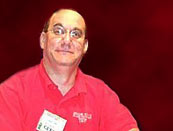 What stage has the project reached?
What stage has the project reached?
The way animation works, things happen simultaneously. We have six scripts finished, on our way to thirteen. We will be, in the next month, recording those six scripts.
In the meantime, we are doing what is called a model pack, which means we are getting [to understand] how the characters are going to look, but not in any kind of animated form. We are first seeing what they look like on the page. Let's see what they look like when you turn them - front, back, centre, upside down, whatever - so that when you do actually get around to animating them, the animation team can say, "Oh, that's what that character looks like from the back." That's gone extraordinarily well.
We cannot yet disclose who our animation team is, because it's not all yet locked down contractually, but we have, in our estimation, the best team working in Saturday morning animation.
When Joss and I first sat down, we hit on the fact that Batman Animated really revolutionised the way that animation looked and felt for the first time in a long time. Because of this, it could reach an audience - a more adult one - which up until then, hadn't been tuning into television animation during the day. Believe it or not, that was ten years ago.
The trick was to bring [to animated Buffy] that level of sophistication with a buoyant new look, so that in the year 2002 people can now say, "Okay, now we've raised the bar that much further." That is really the goal of the show. That is the goal of any project Joss takes on - he sets the bar very high then looks at everybody and says, "How are we going to jump over it?"
The shoulders that we are standing on are Batman Animated, Batman Beyond and the Simpsons. It seems like an odd combination but the thing that the Simpsons does so well is that it manages to pack in an enormous amount of information into 22 minutes, combined with it can shift gears from uproarious comedy to something that's more serious within a matter of seconds. That really is the challenge that's open to us.

